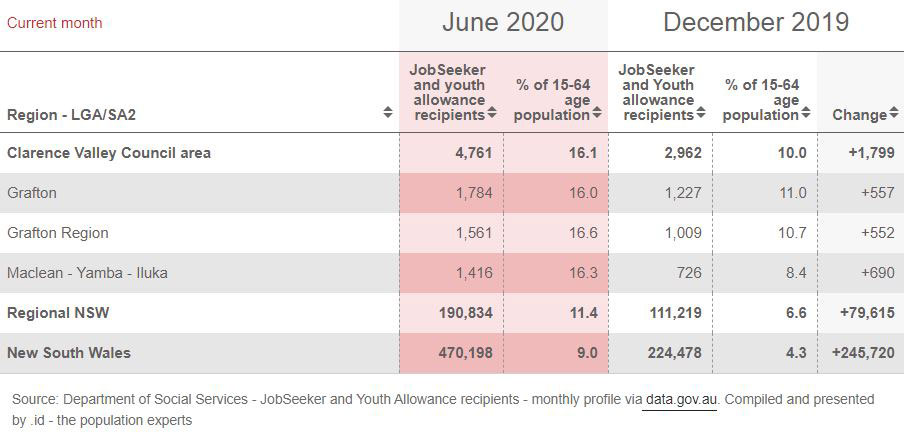While a mini tourism boom delivered some better than usual revenue to some businesses during the July holiday period, the future for workers and businesses in the valley remains under threat, just like the rest of the country, from the COVID-19 pandemic.
Following the Australian Government’s announcement last week, regarding its plans to introduce a two-tiered system and phase in reductions to the JobKeeper and JobSeeker support payments, what lies ahead for Clarence Valley’s workers and businesses when the “sizeable injection of consumer spending power” slows as the changes take place?
The Australian Bureau (ABS) ranks Clarence Valley as the 96th poorest region in the country, and the 16th in NSW, in its Socio-Economic Indexes for Areas (SEIFA), which ranks areas in Australia according to relative socio-economic advantage and disadvantage.
The Regional Australia Institute (RIA) has compiled data that examine the impact the JobKeeer and JobSeeker supplements is having on regional areas.
“The JobKeeper payments have been set at around 70 per cent of the national median wage [equivalent to Australia’s minimum wage], but the variability in median wages across Australia means that the payments are almost 100 per cent of median incomes in some regions,” the RIA writes on its website.
For the Grafton/Coffs Harbour region the JobKeeper payment is estimated to be equivalent to 95.3 per cent of the median income; for JobSeeker it is 70.9 per cent – these estimates rank the region as the fourth most reliant in the country.
According to the RIA, the supplements amount to $45,094,994 (over the six-month period ending in September), which equates to 2.6 per cent of income earned in the Grafton/Coffs Harbour region – 2.6 per cent is the third highest supplement percentage in the country.
The RIA states that: “low median income regions reflect a mix of high unemployment and large retiree populations.
“…In these regions, the value of the JobKeeper payment is almost 100 per cent of median incomes, while the supplemented JobSeeker benefit is over 60 per cent of annual median incomes…
“This means that the income cushion that these payments will provide in these regions will go some way to maintaining consumer spending power.”
Meanwhile, statistics compiled by profile.id.com.au on Clarence Valley Council’s (CVC) website state there were 4,761 people receiving JobSeeker or Youth Allowance payments in the Clarence Valley local government area (LGA), or 16.1 per cent of the population aged from 15 to 64.
This compares to 11.4 per cent across the state’s regional areas and 9 per cent for the entire state.
In December, before the pandemic started (there are no figures for January and February), there were 2,962 people receiving JobSeeker and Youth Allowance (10 per cent) payments.

The regional and state percentages in December were 6.6 per cent and 4.3 per cent.
Meanwhile, over one thousand businesses and not for profits located in the Clarence Valley LGA have signed up for JobKeeper.
The Treasury lists the number of businesses under postcodes, as of midnight June 3, at treasury.gov.au/coronavirus/jobkeeper/data.
The Grafton postcode, 2460, states 638 businesses have signed up.
Other postcodes listed include 2462 (Minnie Water, Wooli, Ulmarra) 69 businesses; 2463 (Maclean) 214 businesses, 2464 (Yamba) 308 businesses; 2465 (Harwood) 10 businesses; 2466 (Iluka) 45 businesses; and, 2469 (Woombah – note: much of this postcode is outside of the Clarence Valley LGA’s boundary) 84 businesses.
Kevin Hogan on the subject: www.clarencevalleynews.com.au/hogan-on-coronavirus-schemes